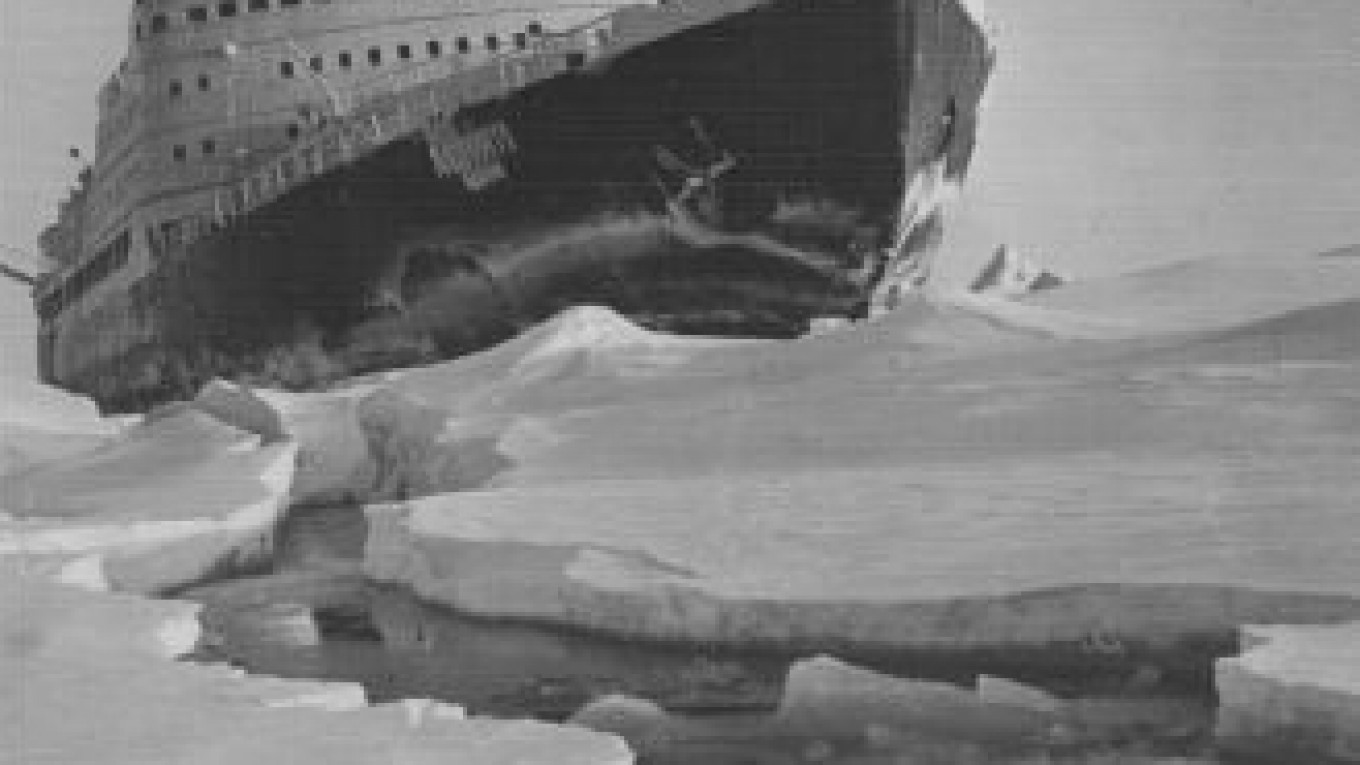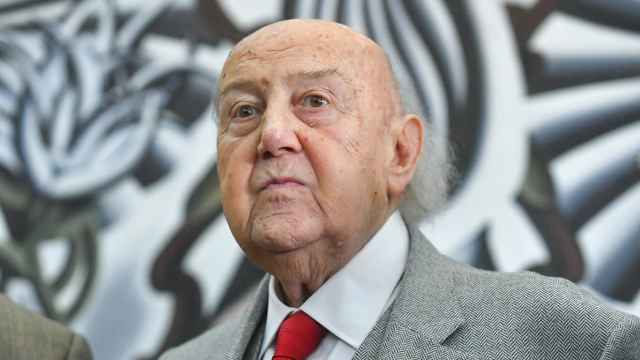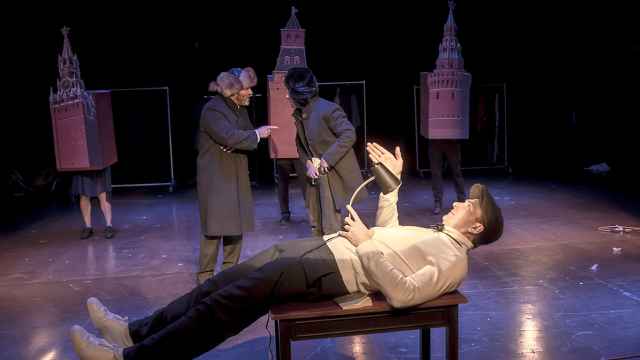The Lenin nuclear icebreaker in the far northern city of Murmansk is the setting of a new international art exhibition that juxtaposes "old Russia" and new. The legendary Soviet ship "Ledakol," decommissioned over 20 years ago, is home to a menagerie of ambitious installations from contemporary European artists, while Moscow hosts a parallel exploration of the project's development.
Artists from Russia, Austria and France prepared works to link the Lenin with the present day through "LENIN:ICEBREAKER," focusing specifically on the temporal and political conflicts in the context of the ongoing 5th Moscow Biennale of Contemporary Art and the Austrian Cultural Season in Russia 2013-14.
People involved in the project include Igor Makarevich and Elena Elagina, who were notorious in the Moscow conceptualist movement; the artist Vladimir Kumashov, local to Murmansk; Judith Fergel; and Michael Strasser. Works range from video installations to conceptual pieces and glass sculptures.
Isa Rosenberger, an Austrian artist who constructed a video installation entitled "The Captain," had it projected onto a large screen in the ship's old canteen. "When I saw the empty screen, I thought it would be beautiful to bring it back to life," she said.
Rosenberger was enchanted by the possibility of participating. "The Captain in question was a man named Vladimir Kogan," she said. "In the Soviet Union, he was in the merchant navy, now he's 83."
Kogan represented not only a bridge between two different times but also "traveling between political ideologies" as well, highlighting the different methods of traveling. The video will also be shown in Moscow's D.E.V.E Gallery in the Krasny Oktyabr chocolate factory from Sept. 20 (which opens more officially to the public on Sept. 21).
Anna Titova, a Russian artist, has a piece installed in the communications room that somewhat resembles a mussel-coated "archaeological relic," as it was termed by one of the exhibition's Austrian curators, Simon Mraz. "She specially did these works for the exhibition," he said. However, she wanted to make them as unremarkable as possible in order to shift focus onto the setting.
"When we came here, some of us were very interested by the timelessness of the place and the ideology behind it," said Titova. "It's an important place for local community, history and how can one work with it? Eventually, I was happy with how it was installed in a way that it would be ignored. … You come to this room in the first place because you know there is an object of art," she added.
"I said to Simon [Mraz] 'if you are happy that I make a work in this way, not something spectacular, and give the chance for the surroundings to be active, then I would like to participate.'"
Some of the artists tailored pieces especially for the ship but were surprised with how the exhibit turned out as a whole. Maria Koshenkova, a Russian artist who has been based in Denmark for the past seven years, works with glass sculpture and created an impressive piece to be installed in the captain's cabin. The model of Lenin appears to have been melted, then subject to an icy blast.
"I thought it could be here" she said, gesturing to a shelf on the ship, "like it actually froze in place." The statue was considered to be more appropriate for the Moscow retrospective in Mraz's eyes. Koshenkova produced a second piece for "Lenin" — a second half to a broken brassy sculpture, also cast in glass. "It took one and a half months instead to make. … It was physically very hard," she laughed.
Artist Svetlana Gabova combined modern technology with old plans from the ship. "There is a program — instaframe — on smartphone," she said, gesturing to one of her five square boards scattered throughout the boat that depicted a Soviet plan layered on top of a newer photo. "It's like looking through a ship window," she added.
Mraz and Stella Rollig, his partner in the project, said the idea was sparked after an initial visit to Murmansk with the Austrian ambassador, Margot Klestil-Löffler. "In the frame of this visit, we got a tour of the icebreaker," Mraz said. He added that he had been "excited" by the prospect and that he thought it was a great place to create an art project.
One of the more initially ambiguous aspects of the exhibition was the setting for the different pieces. While Titova negotiated a space in the communications room and Koshenkova was surprised by her sculpture's relocation to Moscow, other artists had no idea of the plans Mraz had for their works.
"It was only because of my taste," Mraz stated. "I saw it, and I considered … which artist fits best in a special space," he added. The icebreaker itself was decommissioned in 1989. However, this has not stopped Mraz and the team in charge of fostering wild hopes that they could one day sail the exhibition to New York. "No actual steps have been taken though," he laughed.
Murmansk, the world's largest city north of the Arctic Circle, seems the perfect setting for the exhibit because of a parallel clash of old and new. The peaceful rural thicket of red-and-russet trees with the occasional fissure of field or lake is a reminder of a simpler time. Yet as you slowly approach the city from the airport, enormous mines and cylinders, Norilsk Nickel logos, stacks of shining, black greasy barrels, and funnels wallop you in the face with the force of a wrecking ball. It is worth visiting the once "closed city" just to pretend you are living inside Tarkovsky's 'Stalker'.
LENIN:ICEBREAKER will be displayed on board the Lenin Icebreaker in Murmansk until Jan. 10. The exhibition documenting the project's construction will be on display at D.E.V.E Gallery, 11 Bolotnaya Naberezhnaya. Metro Polyanka. It will move to Austria's LENTOS art museum in February next year.
A Message from The Moscow Times:
Dear readers,
We are facing unprecedented challenges. Russia's Prosecutor General's Office has designated The Moscow Times as an "undesirable" organization, criminalizing our work and putting our staff at risk of prosecution. This follows our earlier unjust labeling as a "foreign agent."
These actions are direct attempts to silence independent journalism in Russia. The authorities claim our work "discredits the decisions of the Russian leadership." We see things differently: we strive to provide accurate, unbiased reporting on Russia.
We, the journalists of The Moscow Times, refuse to be silenced. But to continue our work, we need your help.
Your support, no matter how small, makes a world of difference. If you can, please support us monthly starting from just $2. It's quick to set up, and every contribution makes a significant impact.
By supporting The Moscow Times, you're defending open, independent journalism in the face of repression. Thank you for standing with us.
Remind me later.






